The Transformation of “Bodyguard Lane”
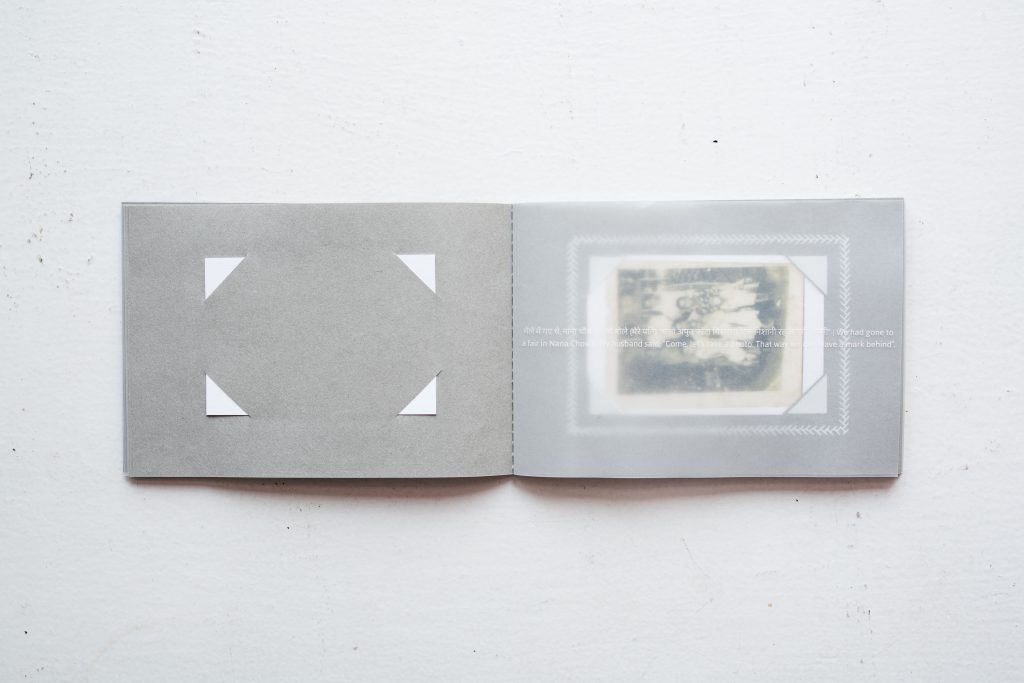
BIND, The Bodyguard Lane Album. 2017.
This work started as a commission carried out by five photographers (BIND) about a
group of families settled and living on a pavement in Central Mumbai (Bodyguard Lane);
it culminated in a photo album especially crafted in conversation with the people of
Bodyguard Lane, as well as a photo exhibition presented during Focus Mumbai
Photography festival in 2017.” People who worked towards this project include : Andrea
Fernandes, Alice Leborgne, Abhinav Sharma, Asmita Parelkar, Abhinav Sharma, Nishant
Shukla, Sunil Thakkar as well as the interviewee, sharing here his own experience and
perspective about his involvement in the project.
- What were your reference points while trying to unearth local histories – could you talk about other books, bodies of works in this context – were you looking at critical discourse around race, class, and caste – research methodology and method in practice?
While some experiments were carried out in 2017 and 2018 respectively in India and France, I actually began to reflect on the subject around 2007, when I was studying social sciences; after a few months of moving from Paris to Delhi for an exchange programme at Jamia Millia Islamia (MCRC), I discovered Louis Malle’s first episode of the Phantom India series, titled The Impossible Camera. Constructed as a travelogue, the voice-over insists on the oppressive potential of the photographic/filmic gaze. I was also introduced to Edward Said’s groundbreaking work on postcolonial literature at the very same time. I started to understand “deconstruction” as a philosophical approach that could be applied to tangible forms and utopian ideals, images as well as the institutions that were responsible for imparting knowledge.
There are many heterogeneous reference points for this alone, but to quote a few I would begin with Bourdieu’s Middle Brow Art, where I learnt how when photographs as objects are produced within and circulated between families – interestingly, primarily by women, they become powerful tools in the assertion of one’s identity. Secondly I was drawn to Foster’s The Artist as Ethnographer where I got introduced to an anthropology of contemporary art and the politics of representation; and finally Christopher Pinney’s Civil Contract of Photography in India, which I heard first as a talk at Delhi Photo Festival in 2013, and that helped me understand the photographic medium as the “pharmakon,” polarised by its potential as a “cure” and a “poison,” and how these notions shift and take on different meanings depending on the context.
What was important to me was that the primary object of focus in all of these references was the photographic object, though the process of approaching Bodyguard Lane was also informed by a certain affinity with subaltern readings on the “history from below”; but my questioning in retrospect was more about the implications of representation itself. The impact certain documentary or experimental films had on my approach is also somewhat crucial: like this woman shouting at Anand Patwardhan’s camera in Bombay, Our City (1985), where she urges him to “not take photographs of the poor”; or in Chronicles of a Summer, by Jean Rouch and Edgar Morin (1961), I was amazed by how the latter Directors screened their film to the subjects they had documented and interviewed during an entire summer in Paris and included that scene in the final cut of the film. Be it for Malle, Rouch/Morin, Patwardhan, I valued a certain explicit self-consciousness of the camera’s gaze, and the fact that the films integrated their subjectivity in an attempt to “unearth a local history.” In terms of the text-image relationship, I can see also how films such as Les Photos d’Alix by Jean Eustache or Nostalgia by Hollis Frampton (1980) have played an immense role in shaping the media experiments I would later engage in.
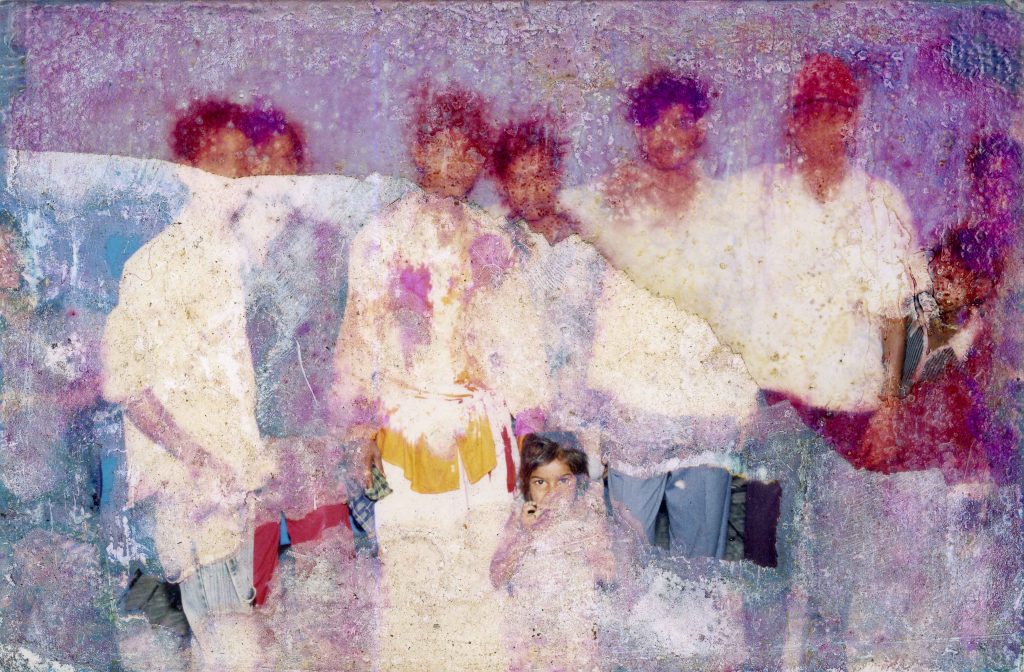
Family photographs get particularly damaged during the rainy season. Digital scan. 2016. Courtesy of Anita Kharwa.
So I think the reference points at play here are broader than just critical discourse within lens-based media and traverse to the domain of the “moving image” – to film and video art. Mainly, what I was trying to tackle was the assumption that there is virtue in giving voice to the under-represented without thorough investigation. We know that this reasoning can be skewed, and every photographer has faced this dilemma at some point–of “representing the other,” which can lead to a kind of “aporia,” where you would become, problematically, only legitimate to speak for your own self.[1&2] There seem to be ways of overcoming this deadlock. I think for instance of the way French artist Christian Boltanski used photography to navigate between his own biography and anonymous subjects, and explored historical themes (such as the Holocaust), yet giving it a universal dimension. Or in the case of a photography specifically, how Jim Goldberg started asking his subjects to write their feelings and thoughts on the photos that he was taking of them. While photography may always carry the burden of representation, people using this medium have increasingly felt the need to play with its form and limits in order to tell stories in a more inclusive, if not ethical way.
- In researching embedded histories – what were the underlying ethical questions you would ask yourself constantly while putting out regional narratives?
I think the main question is – how to put out this so-called “regional” or “local” narrative without labelling it as such in the first place. This question is linked to the one of audience or viewership. If the goal is to “allow” the community to assert or represent itself, then such a labelling can appear instrumental and necessary. It is undeniable that militant art, inscribed in political and social battles, is needed as it can create a certain sense of social awareness and foster mobilisation, which is crucial for the community. But that is only the first stage and if we furthermore aim to produce work for a universal audience, how do we forge a narrative that becomes more complicated and layered? To picture a community as the one that is “oppressed” can trigger a sincere yet fleeting sense of compassion, but it may well be imbued with a sense of superiority as though one were imparting wisdom to the uninitiated. And if Susan Sontag already spoke of “visual fatigue” many decades ago, we must continue to scrutinise the field today, in an era of visual surfeit and bombardment.
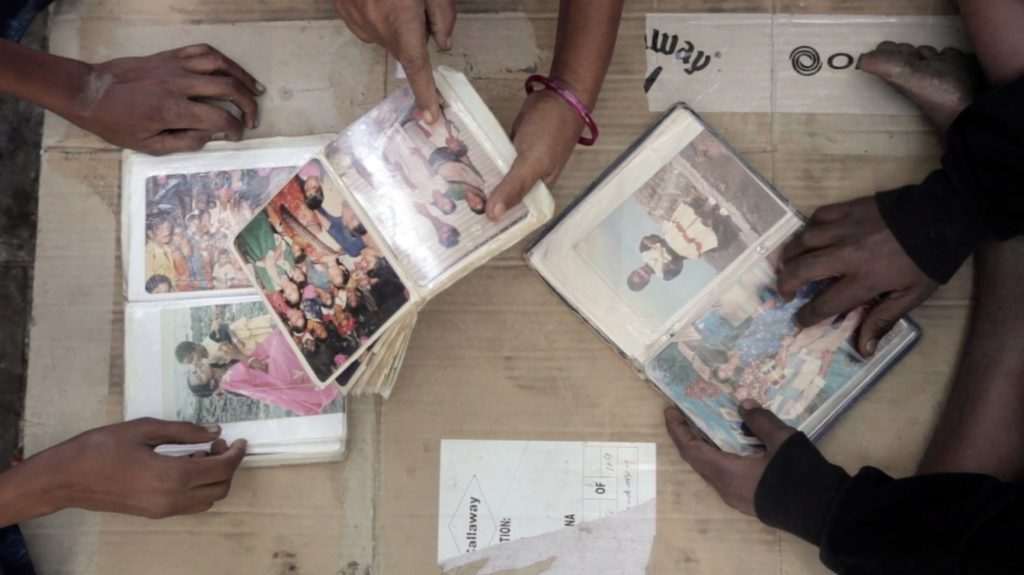
BIND, Nishani Rah Jaegi Apni. Film still. 2016. “While sitting together on the pavement of Bodyguard Lane, the women share stories with us, recalling memories from their family photographs.”
The attempt with our experiments so far was to use what is problematically called “vernacular photography” (be it, in this case, snapshots or studio photos in lower class areas) as the main point of entry for the viewer. The approach itself has many technical fallouts, such as the shift from analog to digital; there is also in general a universal affection imbued with a sense of nostalgia, for old photographic prints, and which seemingly transcends social classes. In that way I see photography as the “great equaliser”: whatever our position in society today, we all acknowledge the value of these family photos as potential tools for deploying and articulating our identity; they give us a sense of our lineage, and we can subsequently summon them to design our future. So when we hear about someone having (almost) lost their photos, I think we are able to start identifying with them. I have witnessed it multiple times, (especially) when I saw the fright on people’s faces when I told them that I had diluted photographs in thinner to produce a video. They were only reassured when I told them it was only a copy, not the original. I was eager therefore to establish a common space so that the local history could be accessible more dispassionately.
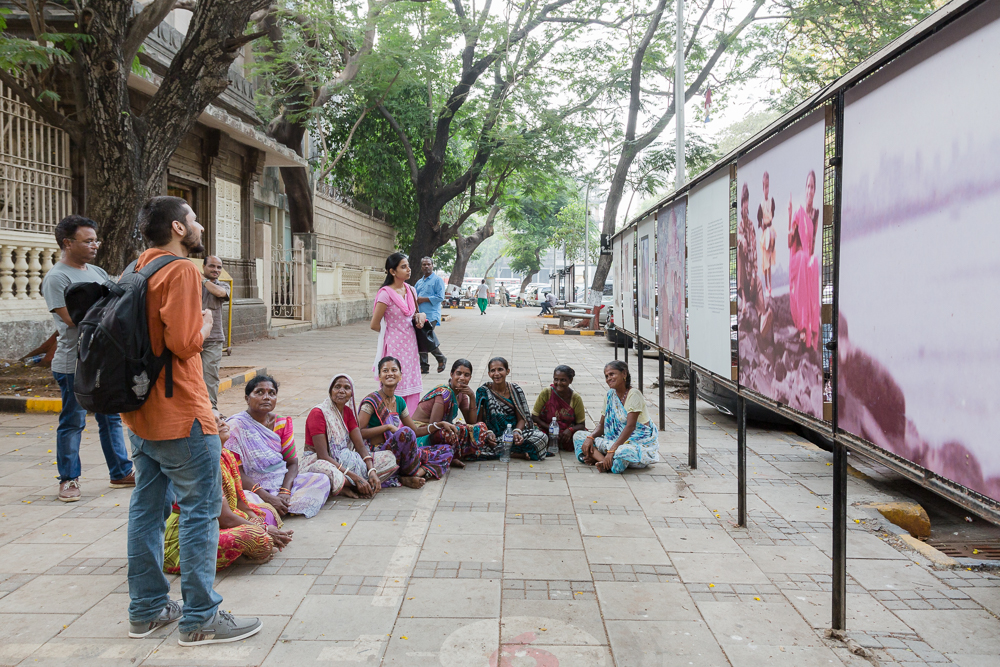
BIND. Abhinav Sharma introduces the outdoor exhibition displayed at Kala Ghoda during the Focus Festival to the women of Bodyguard Lane who had shared their photographs and stories with us. Bombay. March 2017.
Our experiment can be seen as a departure from photography altogether. First we found the need to put down our cameras, then we worked with photos that were no more, of which only a trace was left in peoples memory – a mental image. The larger question at stake was the one of what I would like to term “an economy of memory”: who can afford to store memories? How can a family assert its existence without photos, without an album? Working with family photos clearly does not enable us to overcome the challenge of agency: how can one facilitate the process of self-assertion, by putting into place, those conditions, which would enable the owners of those photos to curate their own history? Therefore I feel that for art practitioners, using “vernacular photography” should be understood as a means and not an end in itself.
- You eventually made an artwork deriving from this archival project. Could you describe the process through which you arrived at the work? Why does the smoke in the video coalesce to form the image? Why are they in a container?
As I intimated in the first question, artistic motivations cannot be seen as post-facto. They are embedded in the very premises of the act of preserving those photos, with which the project began. Retrospectively, it is difficult to claim that we helped to construct an “archive,” because it was not systematised, and mainly stemmed from a feeling of urgency. We wanted to save what might be destroyed given the uncertainty of their living conditions.
It is difficult to precisely identify how it came to this. The particularity of the creative act is also that it relies to a certain extent on intuition. And the same way in which I started photography – by shooting in the street without definite intent or purpose, I still like to operate on instinct.
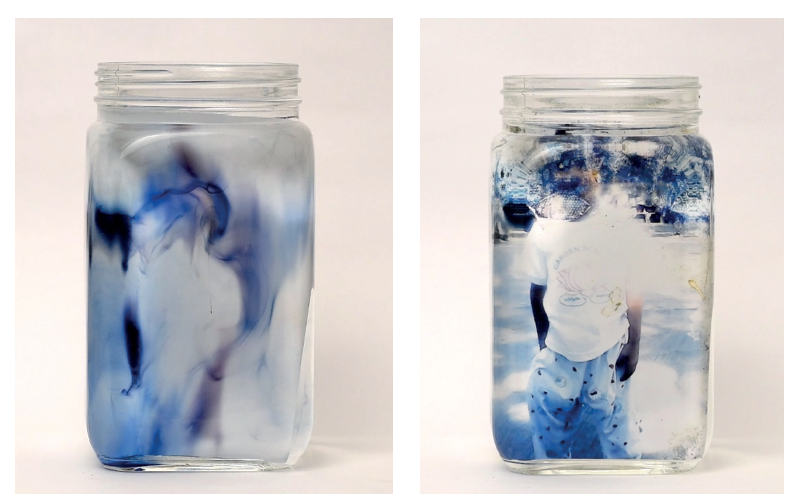
BIND. Video Still. Particular Memories(Bodygaurd Lane). 2017.
This said, I know that I am attracted towards a certain kind of installation work, and so when we were given the opportunity as a collective, BIND, to do something with this collection of photos, I thought of letting the photos disintegrate in water for the whole duration of the festival in which we were supposed to exhibit. I guess I am fascinated by the simple fact that photos, which can value so much, are as fragile as they are physically present. So the idea was to put the photos in various jars and let the prints degrade; but after revising our ambitions due to practical considerations, we actually kept this kind of exploration for the film.
So surprisingly, its presence is a bit accidental, yet there are some connotations which do make sense to me. The first one is scientific and brings to mind the formalin containers in which specimens are preserved – in this case as memories. In this piece, the sound was as important as the visual. At some point, what we hear is the description of family photos that only remain in the memory of individuals. And so one of the interests of this project lies in the relay between the photographic image and a mental one; here a cloud of ink particles thus coalesces on a flat surface, set to music by the ebb and flow of oral memory and the image manifests itself through the fluctuations of a voice. What interests me is the space in between those two images, latent and manifest, which is filled in by the viewer’s feelings and imagination. In the end, I wonder: What does it mean (visually) to remember? And what are the mechanisms behind it?
- In deploying vernacular material in art practice, how do you eventually come to terms with the motivation of the people who are in the photos? What happens to the voice of the subject and what were your concerns when making the artwork?
I don’t know if I’ll ever come to terms with it. But what I can tell you is that right now, for me, this work is not a “piece” as such. It is at most a prototype, precisely because I wish to explore those questions in more depth and refine the work accordingly.
I think the fact that these photos have not been found randomly but collected or shared by their present owner, gives us more responsibility, as well as more scope.
Between 2016 and 2017, BIND collected a fair amount of metadata around those images and so one recurring idea has been to use these interviews and recordings when placing any of those images in public space.
Since we are speaking here about the video, you see that many of the used images are damaged. Some of the photos that are described orally actually do not exist anymore. So there is a certain primacy of the voice of the subject that invokes the visual. But in the end, the photo will always seem more tangible, more real, and objective. That paradox remains.
Philippe Calia is an artist, photographer, and filmmaker, based between France and India.
Interview with Rahaab Allana.
REFERENCES
- “Some questions to ask ourselves would be that if in the majority of cases it is not the subjects that approach the photographer, but the other way around, what makes the photographer assume that the subjects are seeking representation, and that making images of them would elevate their voices to the world? How do we decipher whether the desire for representation on the part of the photographer is motivated not by her own gain of cultural and/or intellectual capital, but in the honest belief that her form will privilege their story?” Tanvi Mishra, “The Great Upheaval,” viewbook. https:// viewbook.com/articles/the-great-upheaval
- “If the starting point is one where we assume this inherent burden of photography, maybe we can be even more conscious of transgressions when these hierarchies become sharper. Sometimes, young photographers react to such conversations and tell me that they feel what they are doing is wrong. Why? Because they are photographing “someone else.” They get so conscious of photographing others; they feel as if there’s something wrong in it. And it’s a very good dilemma to be in, if one can get out of it and find a way forward. I had been in this dilemma for a long time and I still keep getting stuck in it on occasions, and I think it’s very healthy to go through it. Maybe my work will be considered problematic in time; maybe it already is. But I also know that my negotiation through it is more complex than just: ‘This is right, that is wrong.’” Sohrab Hura, in an interview with Skye Arundhati Thomas, studio international, published August 28, 2018. https://www.studiointernational.com/index.php/sohrab-hura-interview-indian-photographer-new-book-coast
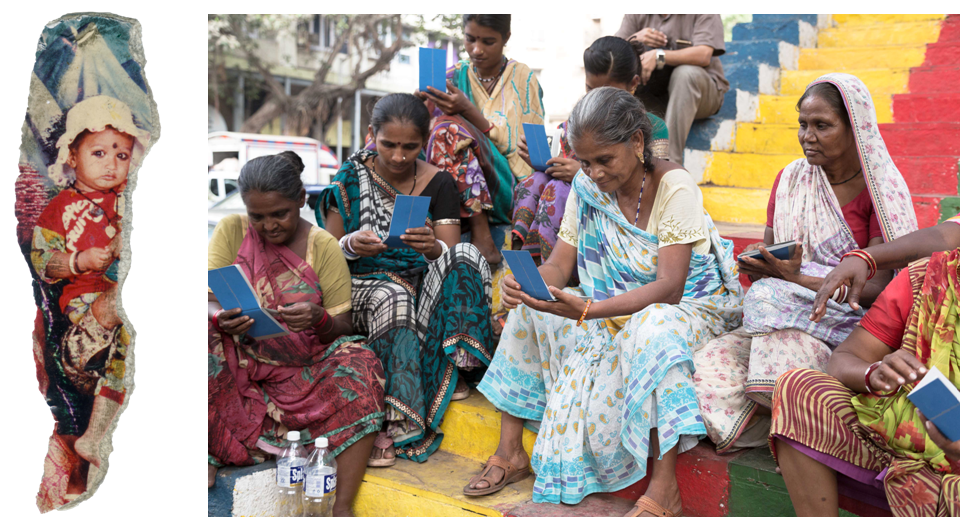 Kanchan as a child. Family photo torn by her and kept as such in her saree blouse. Digital scan. 2016; Madhu and other women of Bodyguard Lane discover the printed album. Bombay. March 2017.
Kanchan as a child. Family photo torn by her and kept as such in her saree blouse. Digital scan. 2016; Madhu and other women of Bodyguard Lane discover the printed album. Bombay. March 2017.
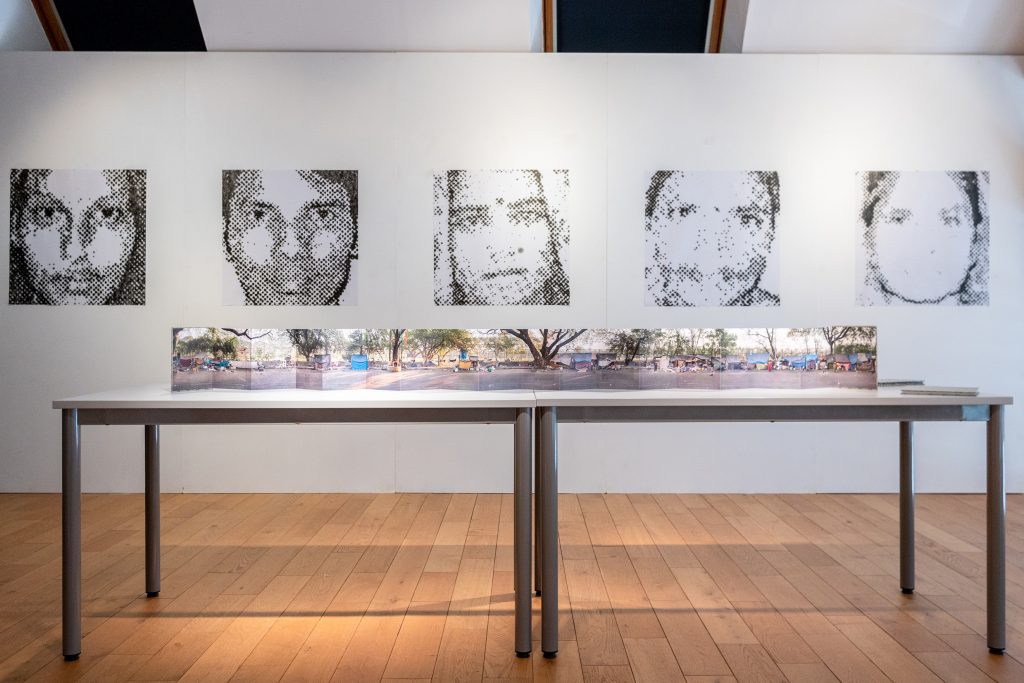
Installation View: BIND, The Bodyguard Lane Album (Work In Progress). A research on memory and identity. Festival Influences Indiennes. Beaucouzé, France. 2018.
Hear Philippe Calia talk about The Bodyguard Lane Album: